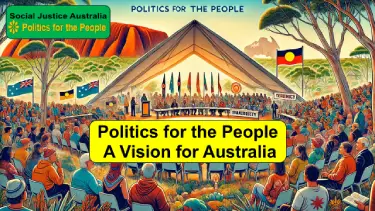Description
Politics for the people. Transform Australian politics into a citizen-first system using monetary sovereignty. Explore reforms for ethical and fair governance.
Introduction: A System in Need of Transformation
Australia’s political system often prioritises corporate interests over citizen welfare. Many Australians feel disillusioned by a system that seems more focused on profits than people. This article explores what politics for the people would look like in Australia, the stark differences from the current system, and actionable steps for achieving this transformation.
By using Australia’s monetary sovereignty and fostering citizen-driven policies, we can create a political landscape where fairness, transparency, and accountability thrive.
The Current State of Australian Politics
Power Concentrated in the Few
Australian politics is heavily influenced by corporate donors and lobbyists. Political campaigns are often funded by large corporations seeking favourable legislation. This creates a cycle where decision-makers prioritise corporate interests over public needs.
Statistics and Evidence
– In 2022, over $200 million in political donations were declared, with most coming from corporations.
– A recent survey revealed 64% of Australians feel their government does not stand for them.
Citizen Disillusionment
The two-party dominance in Australia has created a political environment where many feel their vote doesn’t matter. Disillusionment leads to voter apathy, with declining participation rates in elections and political engagement.
Real-World Impacts
– Policies on housing affordability and healthcare often overlook the needs of the average citizen.
– Many young Australians are stuck in casual or part-time jobs with little security, while policies favour big corporations.
The Consequences of Neoliberalism
Neoliberal policies over the past 40 years have eroded public services and increased inequality. Essential sectors like healthcare, education, and housing have been commercialised, leaving many Australians struggling to access basic services.
Key Examples
– Rising costs of education due to HECS debt policies.
– Public housing has been replaced with private development subsidies, leaving 120,000 Australians homeless.
Envisioning Politics for the People
Hallmarks of a Citizen-Centric Political System
Politics for the people is a citizen-centric political system that places the needs, voices, and participation of the people at the heart of governance. This model contrasts sharply with systems dominated by corporate or party-driven agendas, focusing instead on inclusive, equitable, and transparent decision-making. Here’s a deeper look at how this would work in practice:
Participatory Democracy in Action
– Citizens’ Assemblies: Regular assemblies comprising randomly selected citizens to deliberate on key policies. These groups would represent diverse demographics and work with experts to make informed recommendations on issues like climate change, healthcare, and education.
– Community-Led Referenda: A system where citizens can propose, debate, and vote on legislative changes without relying solely on elected representatives. This ensures grassroots ideas have a direct path to implementation.
– Local Decision-Making Power: Devolving decision-making authority to local governments, allowing communities to address their unique challenges directly.
Transparency and Accountability
– Public Policy Platforms: A digital, publicly accessible platform where citizens can track government actions, spending, and outcomes in real-time. These platforms would also allow feedback loops for citizen input.
– Mandatory Reporting: Elected officials would be required to report back to their constituents regularly, explaining their decisions and how these align with campaign promises.
– Independent Oversight Bodies: Strengthened anti-corruption commissions and watchdog agencies that operate without political interference to maintain integrity.
Inclusivity and Representation
– Proportional Representation: Adopting voting systems that ensure minority and underrepresented groups have a voice in Parliament.
– Diversity Quotas: Policies to encourage greater representation of women, Indigenous Australians, and marginalised communities in political leadership roles.
– Accessible Platforms: Creating forums (both digital and physical) that accommodate people with disabilities, language barriers, or those in remote areas to ensure no voices are excluded.
Citizen-Legislators
– Term Limits: Enforcing term limits for politicians to reduce the entrenchment of career politicians and encourage fresh perspectives in governance.
– Community Engagement Mandates: Requiring politicians to spend a portion of their time actively engaging with local constituents through town halls, surveys, and workshops.
Policy Focus on People, Not Profits
– Social Safety Nets: Prioritising legislation that strengthens universal healthcare, affordable housing, and public education.
– Environmental Responsibility: Establishing citizen panels to guide policies on sustainable development, renewable energy, and conservation efforts.
– Public Funding of Elections: Eliminating corporate donations to ensure campaigns are funded by public money, focusing on ideas rather than financial backing.
Examples from Practice
– Iceland’s Crowdsourced Constitution: In 2011, Iceland invited its citizens to directly participate in drafting a new constitution using social media and citizen assemblies.
– Participatory Budgeting: Cities like Porto Alegre, Brazil, empower citizens to allocate parts of their municipal budgets, fostering transparency and grassroots decision-making.
By integrating these elements, a citizen-centric political system would prioritise fairness, accessibility, and equity, ensuring that governance genuinely serves the people it represents. This model not only increases public trust in government but also empowers individuals to shape policies that directly impact their lives.
Key Features
– Direct Democracy: Citizens have the right to propose and vote on laws.
– Transparency: All government expenditures and decisions are publicly accessible.
Social Justice as a Pillar
Politics for the people would prioritise accessible, fully funded public services to address inequality.
Specific Actions
– Healthcare: A world-class Medicare system that covers dental and mental health.
– Education: Free university and TAFE courses to foster innovation and skill development.
– Housing: Building one million public housing units over the next decade.
Accountability and Representation
To rebuild trust, politics must focus on accountability. This includes empowering independent bodies to oversee government actions and reducing the influence of corporate donations.
Proposed Mechanisms
– Recall Elections: Allow voters to remove underperforming politicians.
– Independent Anti-Corruption Commission: Strengthened powers to investigate corruption at all levels.
Contrasting the Present and the Future
Representation Today vs. Representation Tomorrow
Australia’s current system fosters career politicians who may prioritise party loyalty over community needs. A reimagined system would emphasise citizen legislators—ordinary people standing for their communities.
Economic Priorities
Current policies often subsidise large corporations while ignoring social investment. A politics-for-the-people model would redirect public money to critical areas like renewable energy and infrastructure.
Environmental Sustainability
 Australia’s politics for the people would prioritise bold climate action, including transitioning to renewable energy and restoring natural ecosystems.
Australia’s politics for the people would prioritise bold climate action, including transitioning to renewable energy and restoring natural ecosystems.
Example of Success
Countries like New Zealand have successfully implemented citizen-led climate strategies. Australia could adopt similar models.
Steps to Achieve Politics for the People
Educating and Mobilising Citizens
Civic education is essential for empowering citizens to demand change. Grassroots movements can play a vital role in educating the public about their rights and the power of collective action.
Tools and Resources
– Workshops on civic literacy.
– Online platforms to connect citizens with advocacy groups.
Political Reforms Needed
To bring about this transformation, systemic changes are needed.
Key Reforms
– Public Election Funding: End corporate donations by fully funding elections with public money.
– Citizen-Initiated Referenda: Allow citizens to propose and vote on key issues.
Encouraging Accountability
Strengthening transparency laws and setting up independent media can ensure politicians are held to account.
Actionable Steps
– Strengthen whistleblower protections.
– Implement open data platforms for government spending.
Examples of Success
Global Examples of Citizen-Led Governance
Countries like Iceland and Switzerland have embraced participatory governance, allowing citizens to directly influence policies.
Local Australian Success Stories
Independent candidates and grassroots campaigns have shown the potential for change within Australia.
Challenges to Overcome
Resistance from the Status Quo
Corporate lobbying and political resistance will be significant hurdles. However, a well-informed and engaged citizenry can counteract these forces.
Combatting Apathy
Rebuilding trust will require consistent communication and visible results from reforms.
Conclusion
A politics-for-the-people model offers a pathway to a fairer Australia. By prioritising transparency, accountability, and citizen engagement, we can create a system that truly stands for all Australians.
Question for Readers
How would a citizen-first political system change your community for the better?
Call to Action
If you found this article insightful, explore more about political reform and Australia’s monetary sovereignty on Social Justice Australia: https://socialjusticeaustralia.com.au/.
Share this article with your community to help drive the conversation toward a more just and equal society.
Click on our “Reader Feedback” menu. Let us know how our content has inspired you. Submit your testimonial and help shape the conversation today!
Additionally, leave a comment about this article below.

